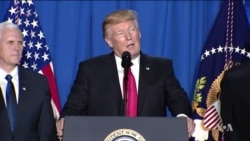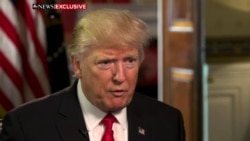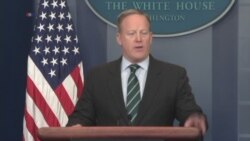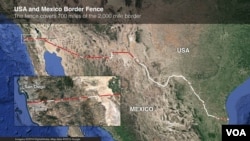President Donald Trump Wednesday ordered construction of a wall along the country’s southern border with Mexico to thwart illegal migration, while Mexican President Enrique Pena Nieto again clearly stated his country will not be picking up the cost.
Trump signed the immigration executive orders as he visited the Department of Homeland Security, the federal agency charged with protecting the U.S. border.
“We are in the middle of a crisis on our southern border. The unprecedented surge of illegal migrants from Central America is harming both Mexico and the United States,” he said. “And I believe the steps we will take, starting right now, will improve the safety in both of our countries. It is going to be very, very good for Mexico.”
Trump told ABC News that construction of the wall would start within months and continued to contend that Mexico would pay for it.
Watch: Trump: Americans Will be Reimbursed by Mexico for Border Wall
Payment plan
“That wall will cost us nothing,” Trump said in the interview broadcast late Wednesday.
He said the payment would perhaps be in a “complicated form,” signaling it would not be a direct payment from Mexico City to Washington. The Washington Post newspaper says money raised by a possible tax on Mexican imports could be used to pay for it.
Pena Nieto reiterated his country’s stance in a message to the Mexican people Wednesday, saying he regrets and disapproves of the decision to build the wall.
“Mexico does not believe in walls. I have said time and time again, Mexico will not pay for the wall,” he said.
Pena Nieto added that Mexico “offers and demands respect as a sovereign nation.”
Republican House Speaker Paul Ryan of Wisconsin praised Trump’s actions in a statement.
“This is about keeping Americans safe. We are committed to working with the administration to stop the influx of illegal immigration along the southern border, protect our homeland, and uphold the rule of law. I applaud President Trump for keeping his promise to make this a national priority,” Ryan said.
Watch: US-Mexico Border Wall
Democratic Senator Robert Menendez of New Jersey condemned the executive order in strong terms.
“This is a terrible and ugly decision by a president who is more concerned with right-wing fringe movements than doing what’s right for all of America, for the economy, and for the future of this country,” Menendez said. “Donald Trump started his campaign by calling Mexicans rapists and murderers, and he is shamefully starting his presidency by declaring open season on immigrants and refugees, and making taxpayers foot the bill for his nativist impulses.”
‘Hostile act’
A senator from the Mexican opposition, Armando Rios Piter, calls the wall a “hostile act” toward the Mexican people. He is urging Pena Nieto to cancel next week’s meeting with Trump.
White House spokesman Sean Spicer said the U.S. would build more detention facilities along the border to house migrants who cross into the U.S. and then give them a “one-way ticket back to the country of their origin.”
Watch: Spicer: Building Wall is "Common Sense"
Spicer said the Trump administration would end what he called the “dangerous catch and release program” border agents currently employ. Migrants are let go after promising to appear in court. Many of them ignore the promise.
The office of the U.N. High Commissioner for Refugees said it was aware of the U.S.-Mexican border issue and would “closely follow the impact” of any wall-building program on people seeking refuge in the United States.
“At a time of enormous needs for the protection of refugees,” a UNHCR statement said, “we hope that the U.S. will continue its strong leadership role and long tradition of protecting those who are fleeing conflict and persecution.”
National security
Currently, there is a barrier along some of the 3,200-kilometer length of the U.S.-Mexico border. U.S. agents patrol the border in vehicles and monitor it with unmanned drones and infrared video.
Trump has said building the wall would be easy, but experts have expressed doubt, noting the rough terrain along the border with regular peaks and valleys.Some of the property along the border is owned privately and the owners say they do not want a wall.
Congressman Bennie Thompson, the ranking Democratic member of the House Homeland Security committee, said the executive order on the U.S.-Mexico border wall “is nothing more than political theater.”
Thompson said the wall will do little to make America’s borders safer.
“The Department of Homeland Security already has the authority to build border fence where there is operational need. Wasting billions on a wall will do nothing to address the thousands of people arriving at our borders, not trying to circumvent the existing fence or evade Border Patrol agents. It will do nothing to address those who come here legally, but overstay their visas,” he said.
Doubts at the border
Residents situated along the southern border hold opposing views, much like the rest of the country. But even among Trump’s supporters, some doubt the wall’s construction will amount to his promises.
“It will never be a complete wall, because of the nondomestic animals that are native to this area,” said Stuart Dilly, a gas station employee 2 kilometers north of the California border. “He might find a way to get around it, but we’ll see. I don’t foresee the wall being any higher than it already is.”
Jairo Carcamo, who crossed the border himself at 15 — seeking refuge from Honduras — isn’t opposed to the wall as a deterrent to drug dealers and “bad people,” but offers an alternative solution.
“Something good [Trump] can do is he can hire more border patrol, right there he’s creating more jobs,” Carcamo said.
But other locals consider Trump’s plans detrimental to a border population of diverse heritage.
Los Angeles-native Leslie Ambriz, a volunteer at the humanitarian nonprofit organization Border Angels, joined a group along the California desert to place jugs of water for crossing migrants. She says a wall’s central purpose is to create a division of people.
“It says we’re better than you,” Ambriz said, “and I don’t think that’s how people are supposed to be treated.”
Cindy Saine at the White House and VOA reporters Jeff Seldin, Ramon Taylor and Margaret Besheer contributed to this report.















